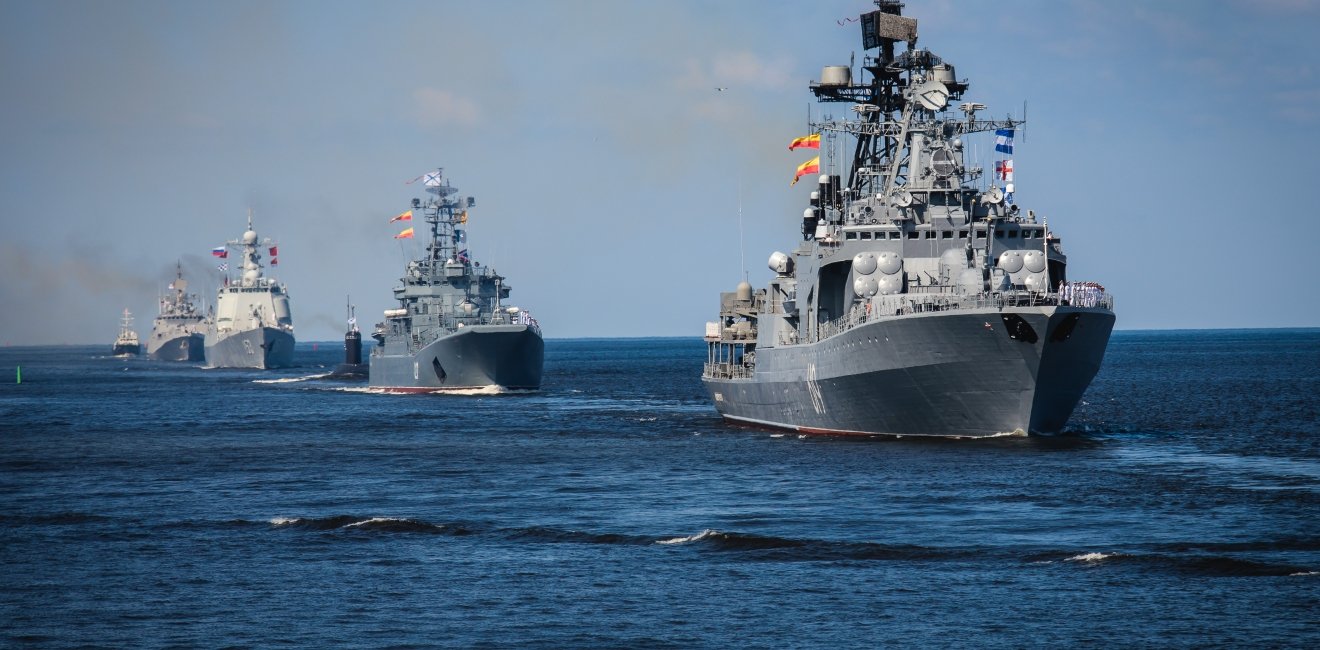
A blog of the Kennan Institute
BY BORYS KORMYCH AND TETYANA MALYARENKO
On June 23, 2021, Russian patrol ships allegedly fired warning shots and an Su-24M aircraft dropped four bombs along the path of the British warship HMS Defender, sailing from Odesa, Ukraine, to Georgia within the 12-nautical-mile (22-km) limit of annexed Crimea's territorial waters. British officials, however, denied it was an attack or that bombs had been dropped along the vessel’s path, characterizing the incident instead as a “gunnery exercise.” The documents discovered in Kent, nevertheless, confirm that the passage was a calculated decision by the British government and the use of a warship in pursuit of coercive diplomatic goals. The most important message of the British Defense Ministry’s statement was that the HMS Defender had been engaged in “innocent passage” through Ukrainian territorial waters as they are defined by international law. Russia’s Defense Ministry, however, said the Defender had violated Russia’s border.
Irrespective of the conflicting narratives about the incident, the statements issued by the two countries clearly marked the opening of another potential front for conflict between Russia and Ukraine and between Russia and the West. Support for this view comes from another, much less known incident: a few days earlier the Defender and the HNLMS Evertsen, a Dutch frigate, had staged a virtual visit to Sevastopol, approaching to within two nautical miles of Russia’s naval base there, through falsification of their automatic identification system positions while they were at mooring in the port of Odesa. This feint is in line with NATO allies’ nonrecognition of Russia’s annexation of the Crimean Peninsula.
The “Crimean question,” public discussion of which had been temporarily relegated to the back burner by the undeclared Russian-Ukrainian war in the Donbas, has a good chance of returning to the international agenda, for several reasons. First, the Crimea Platform, an international diplomacy initiative announced by Ukraine’s President Volodymyr Zelensky, is scheduled to hold its first summit in August 2021; representatives of almost thirty countries are expected to attend. The deoccupation of Crimea is the Platform’s main strategic goal.
Second, Kyiv has intensified its efforts to reequip the Ukrainian Navy, based in the nearby cities of Odesa and Mykolaiv. On June 23, 2021, a memorandum on the rearmament of the Ukrainian Navy was signed by the government of Ukraine and the UK’s Rosyth Royal Dockyard Ltd. Within the framework of broader cooperation in the military-technical sphere, the UK has pledged to provide Ukraine with two Sandown-class minesweeping ships. It will also help Ukraine produce brand-new patrol boats, restore old Ukrainian dockyards, and build two new naval bases in the Black and Azov Seas. In total, Kyiv will receive a £1.25 billion loan to boost its naval capabilities. Although Ukraine's military expenditure is increasing (in 2020 Ukraine occupied 34th place among nations, with an expenditure of £5.9 billion), the loan from the UK, some part of which will go toward the contract with Rosyth Royal Dockyard Ltd., is the most significant deal for the rearmament of the Ukrainian Navy since 2014.
For Kyiv, the achievement of safety and freedom of navigation for Ukrainian vessels in the Black Sea and the Sea of Azov, together with the possibility of at least partially exploiting its exclusive economic zone (EEZ) in the Black Sea, are important tactical goals. In 2014, Russia seized control of the territorial waters around the Crimean Peninsula and with them, a significant part of Ukraine’s EEZ in the vicinity. Russia also blocks trade routes in the Black Sea and the Sea of Azov without warning, citing security reasons or under the pretext of conducting military exercises. As a result, the seaport of Mariupol, connecting the industry of eastern Ukraine with Ukraine’s foreign trade partners, has registered economic losses of about 30 percent.
A second tactical goal of the Crimea Platform is to remind the West of the urgency of supporting Ukraine's security and national interests. Since reintegration of the self-proclaimed republics of Donetsk and Luhansk into Ukraine according to the Minsk agreements shows no signs of progressing, and meetings in the Normandy format have become rare, in part because Russia considers the Crimean issue closed and non-negotiable, the Crimea Platform may replace the Normandy format as the main diplomatic avenue for Kyiv to explain its interests to, and gain support from, the West.
Maritime Gray Area
Overshadowing the issue of reintegrating the unrecognized, self-proclaimed republics of Donetsk and Luhansk in the face of Russian intransigence is the “deeper gray” area of coastal state rights, compounded by a certain lack of clarity surrounding the legal regime of maritime zones. In the Black Sea, shared by Russia and Ukraine, existing disputes over coastal state rights and shipping transit constitute an inviting area for other players to operate, raising the risk of further bellicose actions or costly vessel detentions. This gray area includes a portion of Ukrainian coastal waters around annexed Crimea, where Russia exercises effective control.
The problem acquires additional complexity because the broader area around the 12-nautical-mile zone claimed by Russia as its territory after the annexation of Crimea and where Russia conducts various interference and interception maritime activities “cannot be determined to constitute the exclusive economic zone of the Russian Federation or Ukraine,” according to the Permanent Court of Arbitration Tribunal in The Hague. With respect to Russia’s claims that its border was violated, maritime law permits all nations to carry out certain maritime activities regardless of the jurisdiction of a specific state. Among those activities is innocent passage (please see map on page 14).
A strategy for Ukraine to regain its influence in the Black Sea could comprise three consecutive steps. The first step would entail securing its rights in its territorial waters (the 12-nautical-mile zone) near mainland Ukraine. The second step would be the more difficult one of establishing a balance of power in the coastal waters closer to the Ukrainian mainland that can legally be claimed by Ukraine regardless of the status of Crimea. The third and most challenging step would be to maintain a robust presence in those waters that Russia considers its own following the annexation of Crimea.
In the event of possible incidents in the Black Sea or the Sea of Azov (such as the Kerch Strait incident in 2018), Kyiv can appeal directly to Moscow as a party to the conflict. In the Black Sea, Kyiv could also apply coercive diplomacy tools, demonstrating its presence not only in the Ukraine-controlled territorial waters and the Ukraine-controlled EEZ but also in the territorial waters and EEZ of the annexed Crimea. Today, only the low capacity of the Ukrainian Navy stands in the way of Kyiv pursuing a more active defense of its interests in the Black Sea.
The rearmament of the Ukrainian Navy, however, is unlikely to pose a threat of military conflict between Russia and Ukraine in the Black Sea that might lead to involvement of NATO member states. The nature of the weapons supplied to the Ukrainian Navy suggests that the navy will be used as a tool of coercive diplomacy but that it is not projected to participate in a full-fledged war against Russia at sea.
Notes
1. Tetyana Malyarenko gratefully acknowledges financial support from the Erasmus+ Programme of the European Union (Jean Monnet Project ‘The EU’s Cyber Security and Digital Diplomacy: Strengthening the Bridge between Research and Policy’ N 2019-1871/001-001).
The opinions expressed in this article are those solely of the authors and do not reflect the views of the Kennan Institute.
Authors



Kennan Institute
After more than 50 years as a vital part of the Wilson Center legacy, the Kennan Institute has become an independent think tank. You can find the current website for the Kennan Institute at kennaninstitute.org. Please look for future announcements about partnership activities between the Wilson Center and the Kennan Institute at Wilson Center Press Room. The Kennan Institute is the premier US center for advanced research on Eurasia and the oldest and largest regional program at the Woodrow Wilson International Center for Scholars. The Kennan Institute is committed to improving American understanding of Russia, Ukraine, Central Asia, the South Caucasus, and the surrounding region through research and exchange. Read more

Explore More in Focus Ukraine
Browse Focus Ukraine
Talking to the Dead to Heal the Living

Ukrainian Issue in Polish Elections


